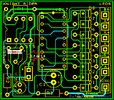Back in the day, when thru hole components ruled the electronics world, I installed a 1 megohm resistor (brown, black, green, gold) instead of a 15 ohm resistor (brown, green, black, gold)… and spent a whole afternoon figuring out the malfunction.
Mind you, this was when I still had perfect eyesight.
Funny you should say that

I was building a number of products at work today, and during the first testing (with a plugged in LCD display, before soldering the final one in place) one of them didn't work



So I finished the rest totally, and went back to check this one to see what was wrong - on closer examination I noticed that the backlight was coming ON, and you could switch the unit ON and OFF, so the processor was running fine. So I thought 'check the LCD contrast, which is set via PWM' - got the scope on it, at the input of the lo-pass filter I'd got a nice 5V pulse, but at the output it was 5V DC (it should be under 1V). So I checked round visually, looking for any silly shorts or whatever, couldn't spot anything - so I checked in and out on the 1K resistor in the simple filter (1K and 10uF), actually on the resistor wires - nice pulse one side, 5V the other.
So, I unplugged the display, and the 5V vanished? - strange I thought?. So I checked the resistor on ohms, to find out it was 27K - looked closely - it
WAS a 27K resistor, not a 1K. So I changed it for a 1K, tried again - it worked

- continued my normal testing routine, to find the opto-coupled output wasn't working. But now I was on top of it - checked the 1K resistor feeding the opto-coupler, to find that was 27K as well. So changed that, everything was good then

Thinking back, I realised where I'd gone wrong - I fit the components a few values at a time, and keep them in 'really useful boxes', labelled with the values. The first three values are 180 x 1, 1K x 2, and 27K x 2 - so as I was assembling PCB's in pairs, I took out two 180 ohms, closed the box, fitted them, then opened the 1K box, took out
two 1K resistors, closed the box, fitted them - then realised I should have taken out
four, not two. So I opened the box again, and took out two more, closed the box, and fitted them - then opened the 27K box, took out four, closed the box, and fitted them.
Obviously the second time I took out the 1K resistors I'd missed, I opened the wrong box, and used 27K instead - dumb stupid mistake, but at least it was easily found and cured.
It doesn't help with these 1% resistors, silly colours, quite small, and not very legible colours either.





